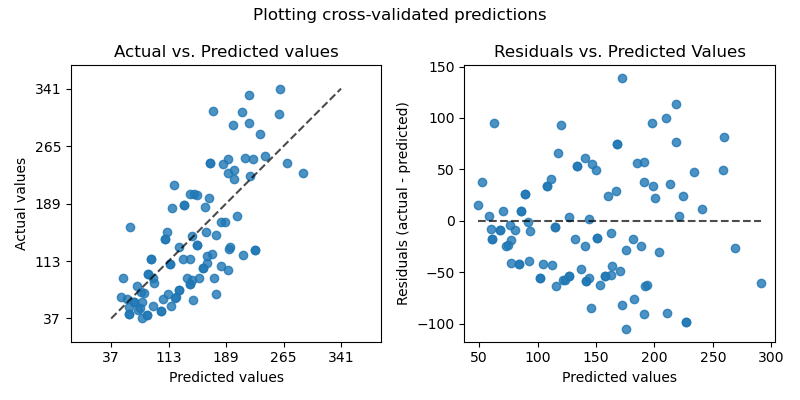Plotting Cross-Validated Predictions (original) (raw)
Note
Go to the endto download the full example code. or to run this example in your browser via JupyterLite or Binder
This example shows how to usecross_val_predict together withPredictionErrorDisplay to visualize prediction errors.
Authors: The scikit-learn developers
SPDX-License-Identifier: BSD-3-Clause
We will load the diabetes dataset and create an instance of a linear regression model.
cross_val_predict returns an array of the same size of y where each entry is a prediction obtained by cross validation.
Since cv=10, it means that we trained 10 models and each model was used to predict on one of the 10 folds. We can now use thePredictionErrorDisplay to visualize the prediction errors.
On the left axis, we plot the observed values \(y\) vs. the predicted values \(\hat{y}\) given by the models. On the right axis, we plot the residuals (i.e. the difference between the observed values and the predicted values) vs. the predicted values.
import matplotlib.pyplot as plt
from sklearn.metrics import PredictionErrorDisplay
fig, axs = plt.subplots(ncols=2, figsize=(8, 4)) PredictionErrorDisplay.from_predictions( y, y_pred=y_pred, kind="actual_vs_predicted", subsample=100, ax=axs[0], random_state=0, ) axs[0].set_title("Actual vs. Predicted values") PredictionErrorDisplay.from_predictions( y, y_pred=y_pred, kind="residual_vs_predicted", subsample=100, ax=axs[1], random_state=0, ) axs[1].set_title("Residuals vs. Predicted Values") fig.suptitle("Plotting cross-validated predictions") plt.tight_layout() plt.show()

It is important to note that we usedcross_val_predict for visualization purpose only in this example.
It would be problematic to quantitatively assess the model performance by computing a single performance metric from the concatenated predictions returned bycross_val_predictwhen the different CV folds vary by size and distributions.
It is recommended to compute per-fold performance metrics using:cross_val_score orcross_validate instead.
Total running time of the script: (0 minutes 0.183 seconds)
Related examples